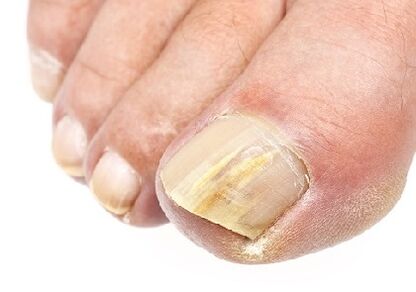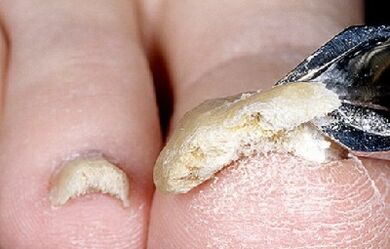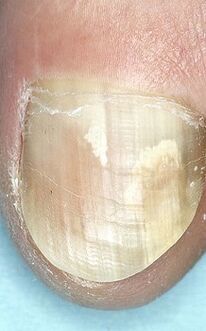What does toenail fungus look like, symptoms and treatment Every third of the people on the planet have faced such problems, such as delamination and chipping of nails, and muddy plates-this is onychomycosis. The disease affects different age groups. Toenail fungus (pictured below) spreads quickly and adapts to the new environment.
Every third of the people on the planet have faced such problems, such as delamination and chipping of nails, and muddy plates-this is onychomycosis. The disease affects different age groups. Toenail fungus (pictured below) spreads quickly and adapts to the new environment.
Consider in more detail the main factors, types and methods of treating fungi at home.
classification
The pathogens of the disease are saprophytes, molds, candida and other pathogenic microorganisms.
Main pathogen types:
- Epidermophyton flocculent. Family fungi that affect the cuticle of the epidermis. After infection, pink flake spots with characteristic fuzzy edges begin to appear on the skin. Spread through touch or household items.
- Trichophyton rubrum and Trichophyton mentagrophytes. These are two yeast-like fungi from the genus Trichopyton. They have a toxic effect, can stay dormant for a long time, and become more active when exposed to negative factors. The first signs of this disease are itching and unpleasant odors between the fingers, followed by rashes and peeling. The color of the outer skin may remain the same.
Mycologists distinguish four types of fungal diseases, which can be caused by various foot fungi:
- The form of erasure is the lightest. It is characterized by slight itching between the fingers and slight peeling of the skin. The cause is Candida saprophytic fungus. The incubation period is 2 weeks. In most cases, the patient does not notice the signs of infection at all, but is spreading the fungus. Even without treatment, the disease will go away on its own.
- Scaly hyperkeratosis. This neglected form of foot fungus can lead to the appearance of deep cracks and damage to the tissues from the legs to the ankles. It is worth noting that in the initial stage of the disease, there is no external manifestation. The soles are not itchy or painful, and small cracks occasionally appear;
- Rubbing or interdigitation is the most common. In most cases, the primary lesion starts in the folds of the thumb and index finger and then spreads along the foot. Possible reasons for the occurrence-contact with the infected person (surface), injury and non-compliance with personal hygiene rules;
- In the form of sweat or blisters-fungal diseases, which cause rashes and local erosions on the epidermis. It is spread entirely by the patient and is rarely diagnosed on the skin of the legs. It is believed that this fungus prefers hands and palms. Without proper treatment, fungal eczema occurs due to exposure to pathogenic microorganisms.
Over time, the fungal infection will progress, although this happens very slowly. Sometimes people live with the fungus for decades, and only start to worry when the nails are completely peeled off, and painful feelings appear. There are several stages in total.
- Initial stage. The fungal infection has just begun to damage the nail, its color changes and its transparency disappears.
- The appearance of hyperkeratosis. This phenomenon, when suffering from fungal disease, nails begin to thicken, become very dense, and sometimes grow strongly. At the end of this stage, the nail plate becomes loose and sometimes the upper layer can be simply scraped off with your fingers.
- In the next stage, the fungal infection moves under the nail. The cuticle is separated from the nail plate, and the nail folds may become red, swollen, and inflamed.
- Operating phase. The nails are shrunken and completely discolored. At this stage, the nail plate is often completely separated or damaged.
It is recommended to suspect nail fungus at the initial stage, and in its advanced form, treatment is difficult and takes a long time, sometimes requiring complete removal of the nail plate. Don't start fungal disease.
symptom
Onychomycosis most often affects toenails and less often hands. The disease starts from the thumb and little finger (the outer edge is affected) and smoothly affects all plates.
The main symptoms of onychomycosis will help identify fungal infections:
- White or green stripes and spots appear under the nails;
- The plate is cloudy and the color changes (from yellow to dark brown);
- Redness and peeling of the skin around the nails;
- Rough appearance between feet and toes;
- Mold forms on the nails.
To know how to recognize the disease at the initial stage, you can see the main manifestations of nail fungus in the photos. This can at least give you a general idea of how the development of the infection started. If you find similar signs, please consult your doctor.
What does the fungus in the photo look like
In any case, the preliminary examination of the legs is done independently. In order not to confuse the fungus with possible corns or ordinary mechanical damage to the foot, we recommend that you study early and late stages of nail fungus photos.
In order not to confuse the fungus with possible corns or ordinary mechanical damage to the foot, we recommend that you study early and late stages of nail fungus photos.

diagnosis
There are more than 50 subspecies of fungi that cause onychomycosis, so its type can only be accurately determined under laboratory conditions. When symptoms appear, initial diagnosis can be made at home from the second stage.
- It is necessary to check the nail plate to determine the location of the fungal infection.
- The next criterion is the shape of the thickness of the nail, the presence of peeling scales and broken pieces.
- The decisive factor may be the color of the infected lesion.
- It is necessary to assess the condition of the skin and hair when onychomycosis is detected: many fungi attack them first and then move to the nail plate.
In some cases, the pathogen is several types of fungal infections. Combinations of dermatophytes and yeast-like fungi or molds and Candida are possible.
Initial treatment of onychomycosis

If this disease occurs, three treatment options are possible, depending on the stage of the fungus. So this:
- Use local drugs;
- Use oral medications;
- Combination therapy.
Local medicines are represented by various ointments, gels, suspensions, emulsions and other types of external preparations. They only act on the lesion and do not penetrate the bloodstream. They are mainly used in the early stages of the development of dermatomycosis or small-scale infections. Usually, treatment ranges from one week to several months, depending on the degree of neglect of the lesion.
- Oral drugs are taken orally and act on pathogens from the body. They have side effects that not only affect the affected area, but also the entire body. In some cases, one application is sufficient, and sometimes a course of treatment is required. They are used for severe lesions and late stages of fungal diseases.
- Combination therapy is used more frequently. The action of topical drugs reduces the intensity of symptoms and accelerates the healing of damaged areas. The tablets act on the pathogens of the disease from the inside.
No treatment plan should interrupt the treatment process. The medication regimen and duration are determined by the doctor. Usually, the treatment is continued for several days (up to a week) after the symptoms and external manifestations of the fungal disease disappear.
Antifungal varnishes and ointments
If the nail fungus has not started but is in its initial stages, it is worth trying varnishes and ointments that help soften the affected area. In this case, the spores of the fungus die under the influence of the drug.
- The most common antifungal varnishes are "terbinafine", "amorolfine" and "ciclopirox". Follow the instructions and apply varnish twice a week for several months until healthy nails have fully grown back.
- Also widely known are: creams-"sertaconazole", "bifonazole", "ketoconazole", "terbinafine"; sprays-"terbinafine" and so on. Suitable for clean and dry surfaces of fingers and nails affected by fungus. The antifungal liquid containing boric acid and resorcinol helps to dry and disinfect affected skin and nails.
- An iodine-based preservative that accelerates the renewal and healing process of the nail itself and the surrounding area. After using the spray, allergic reactions such as burning and itching may occur.
For nail treatment, you should choose a medicine. It is not recommended to alternate or change funds, as such operations will reduce the effectiveness of the treatment. Before starting to use, be sure to read the contraindications. Pregnant women, children and people with individual intolerances are prohibited from using antifungal varnishes for treatment.
Before applying varnish or ointment, the special file that comes with the medicine should be used to remove as much of the nail area affected by the fungus as possible. After degreasing the nails with a water-alcohol solution, apply a coat of varnish, which should be changed every few days. Before the operation, you can soak your feet with soap and soda water. The varnish removal method is the same as for decoration, using organic solvents.
National Science
Nail fungus in the initial stage can be treated with home methods. Folk remedies are a good helper in treating diseases.

- sea salt. This remedy is best combined with conservative treatment. Sea salt bath is the recommended preparation procedure before using topical products. A small amount of hot water, need to add a teaspoon of salt, keep your legs for about 15-20 minutes.
- Use the tray of willow branch decoction 3 times a week. When cooking, collect the buds, chop them, and take 500 grams. Raw materials, pour 2 liters of water. Bring to a boil, reduce heat and let stand for 10 minutes. After the broth has cooled, strain and keep the legs for 20 minutes.
- Tea tree oil. Injured nails should be lubricated before going to bed, bandaged and left overnight. In the morning, remove the dressing, clean the cuticle of the nails, and then drip tea tree oil, but do not bandage it. It is important to continue treatment until healthy nails begin to grow.
- Vinegar bath. Dilute 5 tablespoons in 2 liters of hot water (37 degrees). Lake 9% vinegar. The feet must be soaked in this solution for at least half an hour. Next, use a nail file to remove the softened nail keratinization layer and treat the affected area on the foot and between the toes with pumice stone. After performing such operations, it is recommended to use an anti-fungal cream or solution. Regularly (1-2 times a day) for a month's program.
- Celandine. This plant has long been used to treat nail and skin diseases. Due to the active "burning" effect, it must be handled with care. Celandine juice, decoction and oil based on this plant can be used to fight fungi.
Laser Treatment
Laser therapy is one of the latest treatments for nail fungus, especially in its advanced stages. This method is an alternative to surgical resection and has a long recovery period. During the laser treatment, healthy tissue will not be affected; during the operation, the patient will not feel pain or other unpleasant sensations.
Disadvantages of laser treatment: high price, need to rest between procedures, can only be performed by a qualified dermatologist. Regardless of the choice of treatment, all personal hygiene rules must be followed. Nail fungus may recur, and if it is not treated, the treatment will not be effective.
When treating toenail fungus, regular hygiene procedures are required, socks are changed frequently, and shoes are changed after wearing. The same rules must be followed to prevent nail fungus from recurring after treatment.
prevention
Of course, it is better to prevent fungi than to deal with its consequences for a long time.
How to protect yourself from fungus:
- At the first signs of fungus (itching, redness, peeling), you need salicylic acid ointment to fully lubricate your feet. It has a strong antibacterial effect and moisturizes the skin. On the contrary, chamois or streptocide are also suitable;
- It is important to protect your feet with a protective cream before going to the swimming pool, sauna, gym or other places where you need to take off your shoes.
- Dispose of shoes regularly, and if possible, wash them and dry them outdoors. There is no need to use a special formula for this. Most products can be cleaned from the inside with alcohol or other antibacterial solutions.
In order to strengthen the skin and ensure local immunity, the formula of a preventive mixture based on onions is suitable. Grate an onion with two tablespoons of honey. Apply the resulting paste to the skin of the feet and palms. It is recommended to keep the mask for 30 minutes. Repeat every other day;
















